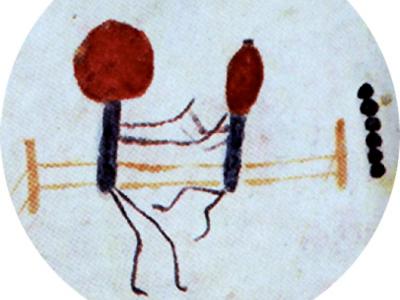Painting with E. coli
Bacteria painting of boxing figures by Alexander Fleming (image by Flickr user AJC1 (bb:cc))
This story was originally covered by PRI’s Studio 360. For more, listen to the audio above.
The myth that surrounds the discovery of penicillin pegs Alexander Fleming as a sloppy scientist. Legend has it that in 1928, Fleming found the mold growing in a petri dish that he accidentally left out overnight. In truth, he was an artist, and his interest in painting with the colorful bacteria may have caused his famous discovery. Today, artist and educator Amy Chase Gulden, and molecular biologist Dr. Kristin Baldwin, are working together to continue Fleming’s vision of painting with microorganisms.
Fleming’s bacterial paintings of a ballerina, a woman’s face, and stick figures boxing survive today. Biologist Rob Dunn explains what made Fleming’s paintings with bacteria different from the watercolor paintings he usually did: “They were ephemeral pictures because eventually the bacteria would continue to grow. They would fight; you know, if you painted a woman’s face, eventually her eye would go over and conquer her forehead.”
The scientist’s artwork literally had a life of it’s own, and its organic nature established an environment for penicillin to appear. Dunn describes the day “a dark sun” started taking over Fleming’s paintings. Studio 360’s Lindsay Patterson continues the story: “Fleming, as an artist, is seeing this beautiful scene of the sun and stars growing in his dish – it’s aesthetically rich, and biologically, it’s his big breakthrough – the sun is penicillin.”
Decades later, Gulden was making art that reminded Dr. Baldwin of plates of bacteria in her lab. So the two decided to start an annual, week-long art and science experiment. Using a benign strain of E. coli — a compound that makes the bacteria blue when it’s incubated — and broth, they paint organic looking pictures in Petri dishes. The process is a lot like painting with their eyes closed, because the “ink” is close to invisible until it is incubated.
Baldwin tells of one reason she likes painting with bacteria: “People are all creeped out, they’re like ‘eeewwww bact..!’ You know, it’s this gross idea — ewww. You know, when they find out what it is that we’re growing. And then they see it, and they’ll say, like, ‘look at how beautiful this organism is.’ So, its kind of fun doing the PR job for bacteria as well.”
————————————————–
PRI’s Peabody Award-winning “Studio 360 with Kurt Andersen” from WNYC is public radio’s smart and surprising guide to what’s happening in pop culture and the arts. Each week, Kurt Andersen introduces you to the people who are creating and shaping our culture. Life is busy — so let “Studio 360” steer you to the must-see movie this weekend, the next book for your nightstand, or the song that will change your life.
